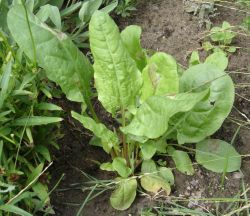Sorrel
- This article is about the common sorrel plant. For horses, see sorrel (horse). For the Oxalis plant, see wood sorrel.
| Sorrel {{{status}}} Fossil range: {{{fossil_range}}}
| ||||||||||||||||||||||||||||||||||||||||||||||||||||||||||||||||||
|---|---|---|---|---|---|---|---|---|---|---|---|---|---|---|---|---|---|---|---|---|---|---|---|---|---|---|---|---|---|---|---|---|---|---|---|---|---|---|---|---|---|---|---|---|---|---|---|---|---|---|---|---|---|---|---|---|---|---|---|---|---|---|---|---|---|---|
 | ||||||||||||||||||||||||||||||||||||||||||||||||||||||||||||||||||
| Plant Info | ||||||||||||||||||||||||||||||||||||||||||||||||||||||||||||||||||
| ||||||||||||||||||||||||||||||||||||||||||||||||||||||||||||||||||
| Scientific classification | ||||||||||||||||||||||||||||||||||||||||||||||||||||||||||||||||||
| ||||||||||||||||||||||||||||||||||||||||||||||||||||||||||||||||||
| [[{{{diversity_link}}}|Diversity]] | ||||||||||||||||||||||||||||||||||||||||||||||||||||||||||||||||||
| {{{diversity}}} | ||||||||||||||||||||||||||||||||||||||||||||||||||||||||||||||||||
| Binomial name | ||||||||||||||||||||||||||||||||||||||||||||||||||||||||||||||||||
| Rumex acetosa L. | ||||||||||||||||||||||||||||||||||||||||||||||||||||||||||||||||||
| Trinomial name | ||||||||||||||||||||||||||||||||||||||||||||||||||||||||||||||||||
| {{{trinomial}}} | ||||||||||||||||||||||||||||||||||||||||||||||||||||||||||||||||||
| Type Species | ||||||||||||||||||||||||||||||||||||||||||||||||||||||||||||||||||
| {{{type_species}}} | ||||||||||||||||||||||||||||||||||||||||||||||||||||||||||||||||||
| {{{subdivision_ranks}}} | ||||||||||||||||||||||||||||||||||||||||||||||||||||||||||||||||||
| [[Image:{{{range_map}}}|{{{range_map_width}}}|]] | ||||||||||||||||||||||||||||||||||||||||||||||||||||||||||||||||||
| Synonyms | ||||||||||||||||||||||||||||||||||||||||||||||||||||||||||||||||||
| {{{synonyms}}} |
Common sorrel, also known as spinach dock and either ambada bhaji or gongoora in Indian cuisine, is a perennial herb that is cultivated as a leaf vegetable.
Sorrel is a slender plant about 60 cm high, with roots that run deep into the ground, as well as juicy stems and edible, oblong leaves. The lower leaves are 7 to 15 cm in length, slightly arrow-shaped at the base, with very long petioles. The upper ones are sessile, and frequently become crimson. The leaves are eaten by the larvae of several species of Lepidoptera including blood-vein.
It has whorled spikes of reddish-green flowers, which bloom in June and July, becoming purplish. The stamens and pistils are on different plants; the ripe seeds are brown and shining.
Common sorrel has been cultivated for centuries. The leaves may be puréed in soups and sauces or added to salads and shav; they have a flavor that is similar to kiwifruit or sour wild strawberries. The plant's sharp taste is due to oxalic acid, and so may be contraindicated in people with rheumatic-type complaints, kidney or bladder stones. Sorrel is also a laxative.
In the Caribbean, sorrel typically refers to Jamaican Red Sorrel or Roselle. A popular dark red sorrel beverage has a sweet, spiced flavor. Roselle is also used in tarts and jellies, and the fiber is used by craftspeople.